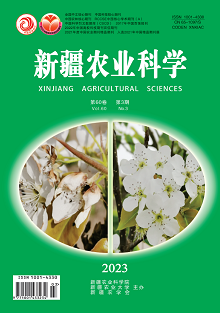【Objective】 Chickpea is suitable to be planted in arid and semi-arid areas with poor soil in China.The variation regularities of chickpea applied with different fertilizations is in urgent need of research.It is important for integrating high-yield cultivation technique of chickpea to explore effects of different nitrogen, phosphorus and potassium treatments on yield on yield, agronomic traits and economic benefit of chickpea, establish the fertilizer response model, and find out the optimal fertilizer rate.【Methods】 Baiying 1 was used in a field experiment designed “3414” incomplete orthogonal regression during 2019 and 2020.The conventional fertilizer rates were N: 58 kg/hm2, P2O5: 69 kg/hm2, K2O: 60 kg/hm2, and four levels of N, P2O5 and K2O in the treatments included 0 (no fertilization), 1(half conventional), 2(conventional) and 3(1.5 folds of conventional).The growth period, plant height, branches, pods per plant, seeds per pod, 100-seed weight, dry matter, root length and yield of chickpea were measured to study the variation of yield and agronomic traits of chickpea at different nitrogen, phosphorus and potassium treatments, and empirical models were established for analyzing the single factor and interaction effects to achieve the optimum rate of fertilizer application.【Results】 The effects of growth period, branches and seeds per pod showed less variation at different fertilization treatments, and the yield was affected by pods per plant and 100-seed weight.The highest value of plant height, pods per plant and 100-seed weight was at N2P2K3, where the root length was longer.The yield of the nitrogen and the potassium deficiency treatments were significantly lower than that of the phosphorus deficiency treatment, and the effects on the yield was N>K2O>P2O5.The single factor and interaction effects of nitrogen, phosphorus and potassium were obvious to the yield and agronomic traits, and the economic benefit was consistent with the yield of chickpea.The corresponding regression equation was acquired by fitting analysis of the yield and agronomic traits at different nitrogen, phosphorus and potassium treatments.The fertilizer rates of nitrogen, phosphorus and potassium at maximum value of each indexes were as below: yield(Y1): 3,801 kg/hm2, N: 75.8 kg/hm2, P2O5: 82.5 kg/hm2, K2O: 90 kg/hm2; plant height(Y2): 84 cm, N: 74.1 kg/hm2, P2O5: 80.1 kg/hm2, K2O: 90 kg/hm2; pods per plant(Y3): 164.9 pods, N: 72.7 kg/hm2, P2O5: 83.7 kg/hm2, K2O: 90 kg/hm2; 100-seed weight(Y4): 38.7 g, shoot dry matter(Y5): 147.6 g, root dry matter(Y6): 6.3 g, root length(Y7): 19.1 cm, N: 87 kg/hm2, P2O5: 103.5 kg/hm2, K2O: 90 kg/hm2.【Conclusion】 The effects of growth period, branches and seeds per pod showed less variation at different fertilization treatments.Under the condition of this experiment, the yield, pods per plant, 100-seed weight, shoot dry matter, root dry matter and root length of chickpea were increased first and then decreased.In the range of this experiment, the shoot dry matter, root dry matter and root length were continuously promoted by the interaction effects of nitrogen, phosphorus and potassium.The highest yield was 3801 kg/hm2 with the optimal fertilizer rates N: 75.8 kg/hm2, P2O5: 82.5 kg/hm2, K2O: 90 kg/hm2.The best economic benefits was 36,853.6 yuan/hm2 with the fertilizer rates N: 74.6 kg/hm2, P2O5: 81.2 kg/hm2, K2O: 90 kg/hm2.

